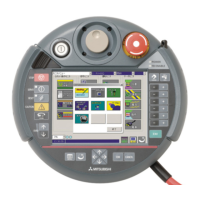APPENDICES
Appendix 2 I/O Signals
55
A
Input signals
This section describes the details on the input signals from the high-speed counter module to the CPU module.
The I/O numbers (X/Y) in this section apply when the start I/O number of the high-speed counter module is set to 0.
This section describes the I/O numbers (X/Y), buffer memory addresses, and external I/O terminals for CH1.
To check the I/O numbers (X/Y) for CH2, refer to the following.
Page 54 List of I/O signals
To check the buffer memory addresses for CH2, refer to the following.
Page 60 List of buffer memory addresses
Module ready
• This signal turns on when the high-speed counter module is ready for counting operations after the CPU module is
powered on or is reset.
• Pulses are not counted while this signal is off.
■Device number
The following table shows the device number of this input signal.
CH1 Counter value larger (point No.1)
• This signal turns on when the value in CH1 Present value (Un\G2 to Un\G3) is larger than the one in CH1 Coincidence
output point No.1 setting (Un\G4 to Un\G5).
• This signal turns off when the value in CH1 Present value (Un\G2 to Un\G3) is equal to or smaller than the one in CH1
Coincidence output point No.1 setting (Un\G4 to Un\G5).
■Device number
The following table shows the device number of this input signal.
CH1 Counter value coincident (point No.1)
• This signal turns on when the value in CH1 Present value (Un\G2 to Un\G3) is equal to the one in CH1 Coincidence output
point No.1 setting (Un\G4 to Un\G5) and the on state will be latched.
• This signal turns off when CH1 Coincidence signal No.1 reset command (Y0) is turned on. Even if the value in CH1 Present
value (Un\G2 to Un\G3) is kept to be equal to the one in CH1 Coincidence output point No.1 setting (Un\G4 to Un\G5), this
signal does not turn on. After once the value in CH1 Present value (Un\G2 to Un\G3) becomes not equal to the one in CH1
Coincidence output point No.1 setting (Un\G4 to Un\G5), this signal turns on when the value in CH1 Present value (Un\G2
to Un\G3) becomes equal to the one in CH1 Coincidence output point No.1 setting (Un\G4 to Un\G5) again.
■Device number
The following table shows the device number of this input signal.
Signal name CH1 CH2
Module ready X0
Signal name CH1 CH2
CH Counter value larger (point No.1) X1 X8
Signal name CH1 CH2
CH Counter value coincident (point No.1) X2 X9

